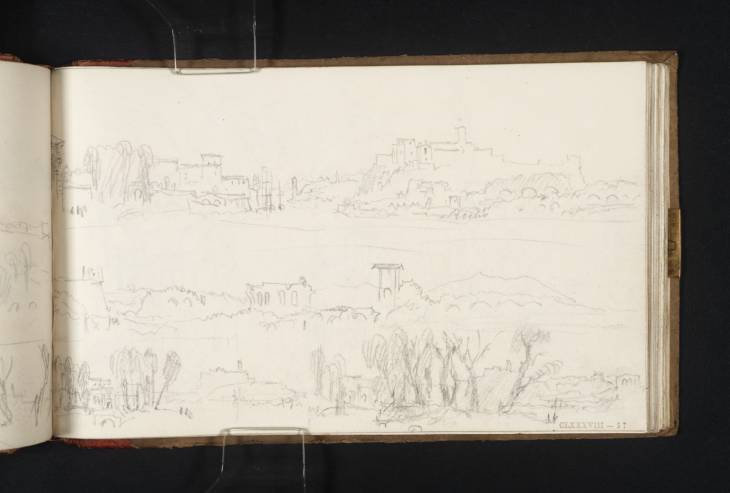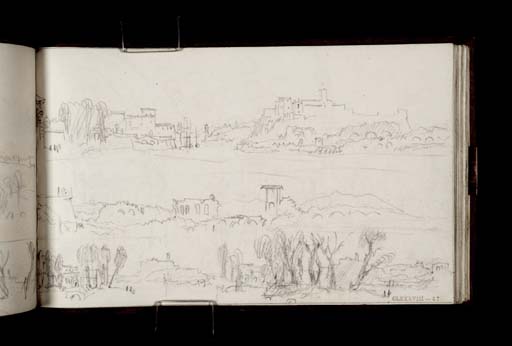Joseph Mallord William Turner Four Sketches of the River Tiber, Including the Porto di Ripa Grande and the Aventine Hill 1819
Image 1 of 2
Joseph Mallord William Turner,
Four Sketches of the River Tiber, Including the Porto di Ripa Grande and the Aventine Hill
1819
Joseph Mallord William Turner 1775–1851
Folio 58 Recto:
Four Sketches of the River Tiber, Including the Porto di Ripa Grande and the Aventine Hill 1819
D16259
Turner Bequest CLXXXVIII 57
Turner Bequest CLXXXVIII 57
Pencil on white wove paper, 114 x 189 mm
Inscribed by the artist in pencil ‘Ruins’ top sketch, bottom centre right
Stamped in black ‘CLXXXVIIII 57’ bottom right
Accepted by the nation as part of the Turner Bequest 1856
References
1909
A.J. Finberg, A Complete Inventory of the Drawings of the Turner Bequest, London 1909, vol.I, p.560, as ‘Four sketches of Aventine Mount (?)’.
1984
Cecilia Powell, ‘Turner on Classic Ground: His Visits to Central and Southern Italy and Related Paintings and Drawings’, unpublished Ph.D thesis, Courtauld Institute of Art, University of London 1984, p.475 note 30.
There are four sketches on this page which appear to show different aspects of the River Tiber from the same location. The largest drawing at the top depicts the view upstream towards the Porto di Ripa Grande on the left and the Aventine Hill on the right. The sketch is drawn from the south-west at a point where the river bends sharply to the east, near present-day Ponte Testaccio. Cargo shipping can be seen docked in front of the customs house of the Ripa Grande, the busiest and most important port in Rome whilst the tall slender column in front is a lighthouse, constructed on the orders of Pope Pius VII in about 1814–15.1 The building in front with the pitched roof and two arched entrances is the Arsenale, which still survives today. Much of the Ripa Grande port, including the lighthouse, was destroyed during the 1880s to make way for the modern walls and embankment flood defences. It can be seen in greater detail on folio 54 verso (D16258; Turner Bequest CLXXXVIII 56a). In the distant centre of this sketch it is possible to see the tower of the Church of Santa Maria in Cosmedin. On the right, on the higher ground of Mount Aventine are the towers of Santa Maria del Priorato and Sant’Alessio all’Aventino (today known as Santi Boniface e Alessio). Beneath this, at the level of the river, the artist has inscribed the word ‘Ruins’ to indicate the remains of the Navali Antichi, the remains of the landing quay of ancient Rome, situated on the eastern bank of the river opposite the Ripa Grande.2 The composition repeats a similar view by the eighteenth-century Italian vedute artist, Giuseppe Vasi (1710–1782).3
The sketch in the middle is drawn from the same position but shows the view on the opposite bank with the surviving section of the Aurelian walls, see folio 57 (D16253; Turner Bequest CLXXXVIII 54). The remaining two sketches at the bottom depict the view looking upstream towards the Aventine Hill. The drawing in the bottom left-hand corner continues on the opposite sheet of the double-page spread, see folio 57 verso (D16254; Turner Bequest CLXXXVIII 54a).
Nicola Moorby
September 2008
How to cite
Nicola Moorby, ‘Four Sketches of the River Tiber, Including the Porto di Ripa Grande and the Aventine Hill 1819 by Joseph Mallord William Turner’, catalogue entry, September 2008, in David Blayney Brown (ed.), J.M.W. Turner: Sketchbooks, Drawings and Watercolours, Tate Research Publication, December 2012, https://www


